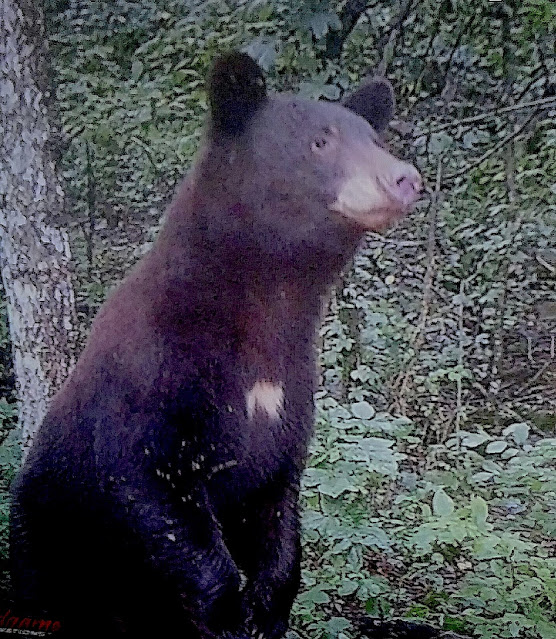 |
Black bear I have photographed in Canada without the garbage dump |
A couple of weeks ago I was talking with guide in Ontario who got a good laugh out of the bear hunting which forbids using bait. He said that without bait, few bears would ever be killed anywhere. In Canada, if you go through an outfitter you are guaranteed to get a shot or several shots, at a bear the first day. But they are always killed over bait.
Lee Arch, a full-blooded Ojibway guide, says no one kills one to eat, as bear that are eating garbage or fish entrails from bait sites are not fit to eat. They are killed only for their pelt, and the making of bear rugs. Bush Pilot and guide Tinker Helseth said that his dad told him when he was a boy, “eat deer, grouse, moose, ducks and geese and fish, then you won’t have to eat bear unless you are starving.”
Twelve-year old Wiley Williams got himself a bear last year, sitting high in a deer stand at the edge of the National Forestland in Christian County. He said his family had land there and had found a ‘marker tree’ which are used by bears which claw the tree as high as they can and use it as a scent post as well. Wiley watched the tree all day and his bear came to it at 3 o’clock. He said he had to shoot it 3 times to kill it. His mother says they kept the hide and want to have it mounted but that expense is great. Wiley said they didn’t eat any of it. He told me it smelled really bad.
Old-time bear hunter, Mike Dodson, from Valley Springs, Arkansas has killed seven bears, all of them over bait in September in Arkansas' National Forest; and all of them with a bow. He says if there are bears killed Missouri, they are killed over bait, whether the hunter wants to admit it or not. "Without bait, there is no chance of killing one," he told me, "I found that piles of popcorn beats out any other kind of bait. They seem to love it."
Mike said he wouldn’t waste a dollar on a bear tag if dogs and baiting were prohibited. He said it was like passing a law prohibiting duck hunting over water.
I have done some bear hunting in Canada with my camera but there is always a community dump in the background or fish entrail buckets close by. One night I arrived at Tinker Helseth’s lodge in Nestor Falls Canada after midnight, so to keep from waking anyone I just slept behind the front seat of my crew-cab pickup, in a very comfortable bed I keep there when I travel. My Labrador was sleeping in the front seat, and his growls awakened me. I felt the pick-up lurch, sat up and opened the frost-covered back window. A black bear was looking back at me, only inches from my face. He stood up tall, clutching a 10-pound bag of dog food in his arms, then jumped over the tailgate and disappeared.
There isn’t room here to tell about the bear attack that occurred in North Arkansas a few years back. You can read about that on my website. I often write 2 or 3 columns per week, not just this one, and you can read all of them on your computer at… larrydablemontoutdoors.blogspot.com. I urge readers to find it on the Internet and read it each week. On that site you can find out how the Missouri Department of Conservation used the idea of a bear season and the elk season to garner nearly 200 thousand dollars in funds from Missouri hunters who never got to hunt either.
Only five elk and eight bears were killed to gain that money. It was paid by about 20,000 Missourians. Of those who pay that in the future, 98 percent of them will never get to hunt either. That fact has not, and can not, be printed in any Missouri newspaper, so find the details on that Internet site.
This year, almost 9 thousand applicants have sent in 10 dollars each to have a chance at 4 elk tags. A fifth elk tag is given to a ‘local landowner’ who is not named. Guess who that unnamed landowner is!! Read the website.
















